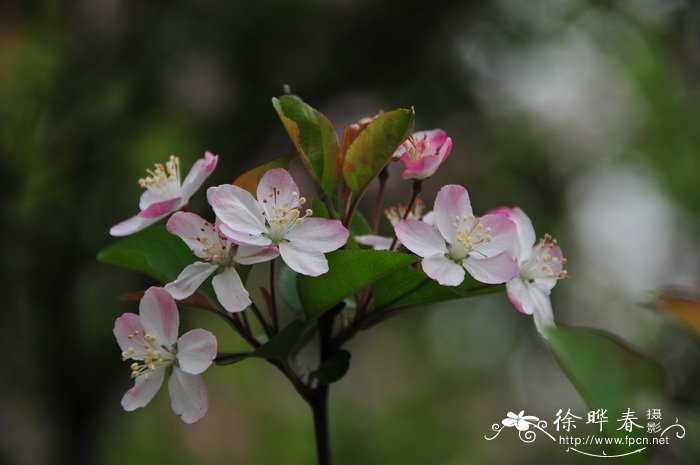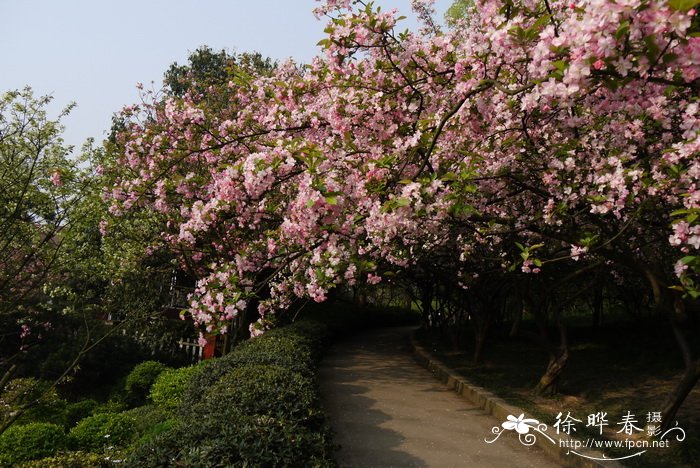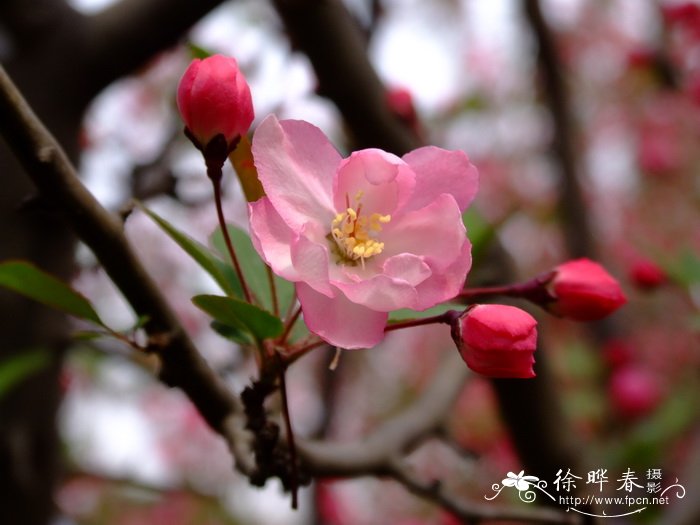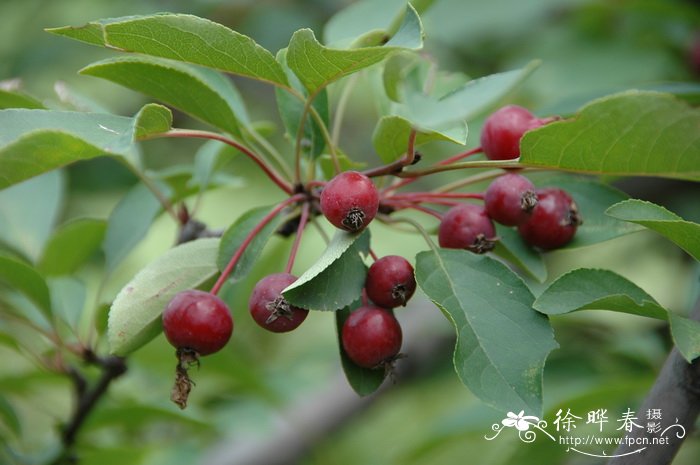垂丝海棠Malus halliana
中文名(Chinese Name):垂丝海棠
学名(Scientific Name):Malus halliana Koehne
英文名(English Common Name):Hall crab apple
别名(Chinese Common Name):
异名(Synonym):Malus floribunda var. parkmanni Koidz. Malus domestica var. halliana (Koehne) Likhonos Pyrus halliana (Koehne) Voss Malus floribunda var. parkmannii (F.L.Temple) Koidz.
科属(Family & Genus):蔷薇科(Rosaceae)苹果属
形态特征(Description):乔木,高达5米,树冠开展;小枝细弱,微弯曲,圆柱形,最初有毛,不久脱落,紫色或紫褐色;冬芽卵形,先端渐尖,无毛或仅在鳞片边缘具柔毛,紫色。叶片卵形或椭圆形至长椭卵形,长3.5-8厘米,宽2.5-4.5厘米,先端长渐尖,基部楔形至近圆形,边缘有圆钝细锯齿,中脉有时具短柔毛,其余部分均无毛,上面深绿色,有光泽并常带紫晕;叶柄长5-25毫米,幼时被稀疏柔毛,老时近于无毛;托叶小,膜质,披针形,内面有毛,早落。伞房花序,具花4-6朵,花梗细弱,长2-4厘米,下垂,有稀疏柔毛,紫色;花直径3-3.5厘米;萼筒外面无毛;萼片三角卵形,长3-5毫米,先端钝,全缘,外面无毛,内面密被绒毛,与萼筒等长或稍短;花瓣倒卵形,长约1.5厘米,基部有短爪,粉红色,常在5数以上;雄蕊20-25,花丝长短不齐,约等于花瓣之半;花柱4或5,较雄蕊为长,基部有长绒毛,顶花有时缺少雌蕊。果实梨形或倒卵形,直径6-8毫米,略带紫色,成熟很迟,萼片脱落;果梗长2-5厘米。花期3-4月,果期9-10月。
分布(Distribution):产江苏、浙江、安徽、陕西、四川、云南,生海拔50-1200米山坡丛林中或山溪边。
用途(Use):落叶小乔木,嫩枝、嫩叶均带紫红色,花粉红色,下垂,早春期间甚为美丽,各地常见栽培供观赏用,有重瓣、白花等变种。
引自中国植物志英文版:FOC Vol. 9 Page 183
Malus halliana Koehne, Gatt. Pomac. 27. 1890.
垂丝海棠 chui si hai tang| Rosaceae | Malus
Malus domestica Borkhausen var. halliana (Koehne) Likhonos; M. floribunda Siebold ex Van Houtte var. parkmanni Koehne; Pyrus halliana (Koehne) Voss.
Trees to 5 m tall. Branchlets purple or purplish brown, terete, slender, puberulous when young, glabrescent; buds purplish brown, ovoid, glabrous or scales ciliate at margin. Stipules caducous, lanceolate, small, 4–6 mm, membranous, puberulous adaxially, margin glandular denticulate when young, apex acuminate; petiole 0.5–2.5 cm, sparsely pubescent when young, glabrescent; leaf blade dark green and often tinged purple adaxially, ovate, elliptic, or narrowly elliptic, 3.5–8 × 2.5–4.5 cm, glabrous except sometimes puberulous along midvein, base cuneate or subrounded, margin obtusely serrulate, apex long acuminate. Corymb 4–6 cm in diam., 4–6-flowered; bracts caducous, lanceolate, membranous, margin entire, apex acuminate. Pedicel pendulous, purple, 2–4 cm, slender, sparsely pubescent. Flowers 3–3.5 cm diam. Hypanthium glabrous abaxially. Sepals triangular-ovate, 3–5 mm, ca. as long as or slightly shorter than hypanthium, abaxially glabrous, adaxially tomentose, margin entire, apex obtuse. Petals often more than 5, pink, obovate, ca. 1.5 cm, base shortly clawed, apex rounded. Stamens 20–25, unequal, ca. 1/2 as long as petals. Ovary 4- or 5-loculed, with 2 ovules per locule; styles 4 or 5, slightly longer than stamens, long tomentose basally. Pome purplish, pyriform or obovoid, 6–8 mm in diam.; fruiting pedicel 2–4 cm, subglabrous; sepals caducous; with a small scar at apex. Fl. Mar–Apr, fr. Sep–Oct. 2n = 34*, 51*.
Thickets on slopes or by streams; sea level to 1200 m. Anhui, Guizhou, Hubei, Jiangsu, Shaanxi, Sichuan, Yunnan, Zhejiang.
This species has been used as an ornamental because of its purplish red young branches and leaves and pink, showy flowers in the spring.
According to Bean (Trees Shrubs Hardy Brit. Isles, ed. 8, 2: 699. 1981), this is a Japanese species and does not occur in China. Further study is required on Chinese specimens attributed to Malus halliana.
Malus halliana is similar to M. baccata, which differs by its serrulate leaves, white petals, and apically acuminate sepals larger than the hypanthium.




(责任编辑:徐晔春)
学名(Scientific Name):Malus halliana Koehne
英文名(English Common Name):Hall crab apple
别名(Chinese Common Name):
异名(Synonym):Malus floribunda var. parkmanni Koidz. Malus domestica var. halliana (Koehne) Likhonos Pyrus halliana (Koehne) Voss Malus floribunda var. parkmannii (F.L.Temple) Koidz.
科属(Family & Genus):蔷薇科(Rosaceae)苹果属
形态特征(Description):乔木,高达5米,树冠开展;小枝细弱,微弯曲,圆柱形,最初有毛,不久脱落,紫色或紫褐色;冬芽卵形,先端渐尖,无毛或仅在鳞片边缘具柔毛,紫色。叶片卵形或椭圆形至长椭卵形,长3.5-8厘米,宽2.5-4.5厘米,先端长渐尖,基部楔形至近圆形,边缘有圆钝细锯齿,中脉有时具短柔毛,其余部分均无毛,上面深绿色,有光泽并常带紫晕;叶柄长5-25毫米,幼时被稀疏柔毛,老时近于无毛;托叶小,膜质,披针形,内面有毛,早落。伞房花序,具花4-6朵,花梗细弱,长2-4厘米,下垂,有稀疏柔毛,紫色;花直径3-3.5厘米;萼筒外面无毛;萼片三角卵形,长3-5毫米,先端钝,全缘,外面无毛,内面密被绒毛,与萼筒等长或稍短;花瓣倒卵形,长约1.5厘米,基部有短爪,粉红色,常在5数以上;雄蕊20-25,花丝长短不齐,约等于花瓣之半;花柱4或5,较雄蕊为长,基部有长绒毛,顶花有时缺少雌蕊。果实梨形或倒卵形,直径6-8毫米,略带紫色,成熟很迟,萼片脱落;果梗长2-5厘米。花期3-4月,果期9-10月。
分布(Distribution):产江苏、浙江、安徽、陕西、四川、云南,生海拔50-1200米山坡丛林中或山溪边。
用途(Use):落叶小乔木,嫩枝、嫩叶均带紫红色,花粉红色,下垂,早春期间甚为美丽,各地常见栽培供观赏用,有重瓣、白花等变种。
引自中国植物志英文版:FOC Vol. 9 Page 183
Malus halliana Koehne, Gatt. Pomac. 27. 1890.
垂丝海棠 chui si hai tang| Rosaceae | Malus
Malus domestica Borkhausen var. halliana (Koehne) Likhonos; M. floribunda Siebold ex Van Houtte var. parkmanni Koehne; Pyrus halliana (Koehne) Voss.
Trees to 5 m tall. Branchlets purple or purplish brown, terete, slender, puberulous when young, glabrescent; buds purplish brown, ovoid, glabrous or scales ciliate at margin. Stipules caducous, lanceolate, small, 4–6 mm, membranous, puberulous adaxially, margin glandular denticulate when young, apex acuminate; petiole 0.5–2.5 cm, sparsely pubescent when young, glabrescent; leaf blade dark green and often tinged purple adaxially, ovate, elliptic, or narrowly elliptic, 3.5–8 × 2.5–4.5 cm, glabrous except sometimes puberulous along midvein, base cuneate or subrounded, margin obtusely serrulate, apex long acuminate. Corymb 4–6 cm in diam., 4–6-flowered; bracts caducous, lanceolate, membranous, margin entire, apex acuminate. Pedicel pendulous, purple, 2–4 cm, slender, sparsely pubescent. Flowers 3–3.5 cm diam. Hypanthium glabrous abaxially. Sepals triangular-ovate, 3–5 mm, ca. as long as or slightly shorter than hypanthium, abaxially glabrous, adaxially tomentose, margin entire, apex obtuse. Petals often more than 5, pink, obovate, ca. 1.5 cm, base shortly clawed, apex rounded. Stamens 20–25, unequal, ca. 1/2 as long as petals. Ovary 4- or 5-loculed, with 2 ovules per locule; styles 4 or 5, slightly longer than stamens, long tomentose basally. Pome purplish, pyriform or obovoid, 6–8 mm in diam.; fruiting pedicel 2–4 cm, subglabrous; sepals caducous; with a small scar at apex. Fl. Mar–Apr, fr. Sep–Oct. 2n = 34*, 51*.
Thickets on slopes or by streams; sea level to 1200 m. Anhui, Guizhou, Hubei, Jiangsu, Shaanxi, Sichuan, Yunnan, Zhejiang.
This species has been used as an ornamental because of its purplish red young branches and leaves and pink, showy flowers in the spring.
According to Bean (Trees Shrubs Hardy Brit. Isles, ed. 8, 2: 699. 1981), this is a Japanese species and does not occur in China. Further study is required on Chinese specimens attributed to Malus halliana.
Malus halliana is similar to M. baccata, which differs by its serrulate leaves, white petals, and apically acuminate sepals larger than the hypanthium.
(责任编辑:徐晔春)
踩一下[2]

顶一下[8]